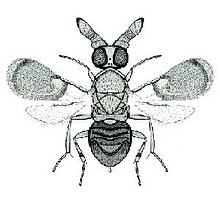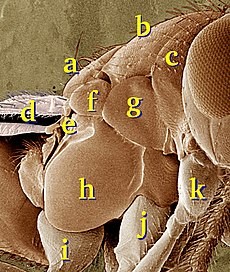Encyrtidae: Difference between revisions
PsychoMaple (talk | contribs) mNo edit summary |
added a brief couple of sentences and parasitism being a potential threat to population stability of other species. |
||
| Line 12: | Line 12: | ||
[[Tetracneminae]] |
[[Tetracneminae]] |
||
}} |
}} |
||
'''Encyrtidae''' is a large family of [[parasitic wasp]]s, with some 3710 described species in about 455 [[List of encyrtid genera|genera]]. The [[larva]]e of the majority are primary [[parasitoid]]s on [[Hemiptera]], though other hosts are attacked, and details of the life history can be variable (e.g., some attack eggs, some attack larvae, others are [[hyperparasite]]s, and some Encyrtidae develop as parasitoids of [[tick]]s). They are found throughout the world in virtually all habitats, and are extremely important as [[biological control]] agents. |
'''Encyrtidae''' is a large family of [[parasitic wasp]]s, with some 3710 described species in about 455 [[List of encyrtid genera|genera]]. The [[larva]]e of the majority are primary [[parasitoid]]s on [[Hemiptera]], though other hosts are attacked, and details of the life history can be variable (e.g., some attack eggs, some attack larvae, others are [[hyperparasite]]s, and some Encyrtidae develop as parasitoids of [[tick]]s). They are found throughout the world in virtually all habitats, and are extremely important as [[biological control]] agents. They may also present as an ecological threat to the population of some species. For example, the endangered ''[[Papilio homerus]]'' butterfly is parasitized at a rate of 77%.<ref>{{Cite book|url=https://link.springer.com/chapter/10.1007/978-1-4020-8782-0_16|title=Insect Conservation and Islands|last=Garraway|first=Eric|last2=Bailey|first2=A. J. A.|last3=Freeman|first3=B. E.|last4=Parnell|first4=J. R.|last5=Emmel|first5=T. C.|date=2008|publisher=Springer, Dordrecht|isbn=9781402087813|pages=189–203|language=en|doi=10.1007/978-1-4020-8782-0_16}}</ref> Parasitic wasps are the main contributor to egg mortality in the butterfly species. |
||
Some species exhibit a remarkable developmental phenomenon called "[[polyembryony]]", in which a single egg multiplies clonally in the host and produces large numbers of identical adult wasps. Even more remarkably, some of the larvae are larger than the others and act in a similar way to the "soldiers" of [[eusocial]] insects, attacking any other wasp larvae already in the body of the host, and dying without reproducing ("[[altruism]]"). |
Some species exhibit a remarkable developmental phenomenon called "[[polyembryony]]", in which a single egg multiplies clonally in the host and produces large numbers of identical adult wasps. Even more remarkably, some of the larvae are larger than the others and act in a similar way to the "soldiers" of [[eusocial]] insects, attacking any other wasp larvae already in the body of the host, and dying without reproducing ("[[altruism]]"). |
||
Revision as of 02:27, 14 November 2017
| Encyrtidae Temporal range:
| |
|---|---|

| |
| Anicetus communis | |
| Scientific classification | |
| Domain: | Eukaryota |
| Kingdom: | Animalia |
| Phylum: | Arthropoda |
| Class: | Insecta |
| Order: | Hymenoptera |
| Superfamily: | Chalcidoidea |
| Family: | Encyrtidae Walker, 1837 |
| Subfamilies | |
| Diversity | |
| Two subfamilies of around 3710 species in 455 genera | |
Encyrtidae is a large family of parasitic wasps, with some 3710 described species in about 455 genera. The larvae of the majority are primary parasitoids on Hemiptera, though other hosts are attacked, and details of the life history can be variable (e.g., some attack eggs, some attack larvae, others are hyperparasites, and some Encyrtidae develop as parasitoids of ticks). They are found throughout the world in virtually all habitats, and are extremely important as biological control agents. They may also present as an ecological threat to the population of some species. For example, the endangered Papilio homerus butterfly is parasitized at a rate of 77%.[1] Parasitic wasps are the main contributor to egg mortality in the butterfly species.
Some species exhibit a remarkable developmental phenomenon called "polyembryony", in which a single egg multiplies clonally in the host and produces large numbers of identical adult wasps. Even more remarkably, some of the larvae are larger than the others and act in a similar way to the "soldiers" of eusocial insects, attacking any other wasp larvae already in the body of the host, and dying without reproducing ("altruism").
Wasps in this family are relatively easy to separate from other Chalcidoidea by features of the wing venation, the migration of the cerci forwards on the metasoma (and accompanying distortion of the tergites), and a greatly enlarged mesopleuron with anteriorly positioned mesocoxae.

An extinct genus Archencyrtus has been described from the Middle Eocene age Sakhalin amber in Eastern Russia.[2]
References
- ^ Garraway, Eric; Bailey, A. J. A.; Freeman, B. E.; Parnell, J. R.; Emmel, T. C. (2008). Insect Conservation and Islands. Springer, Dordrecht. pp. 189–203. doi:10.1007/978-1-4020-8782-0_16. ISBN 9781402087813.
- ^ Simutnik, S.A. (2014). "The first record of Encyrtidae (Hymenoptera, Chalcidoidea) from the Sakhalin amber". Paleontological Journal. 48 (6): 621–623. doi:10.1134/s0031030114060124.
External links
- Universal Chalcidoidea Database
- Image Database TOBIKOBACHI Based on the Encyrtid Wasp Collection of Dr. T. Tachikawa
- Ageniaspis citricola on the UF / IFAS Featured Creatures Web site
- Diaphorencyrtus aligarhensis on the UF / IFAS Featured Creatures Web site
